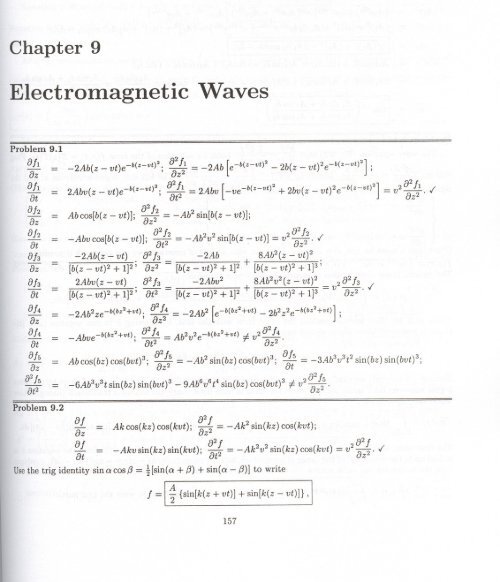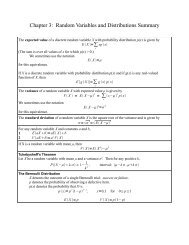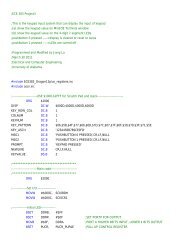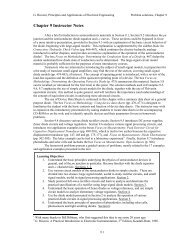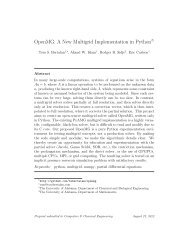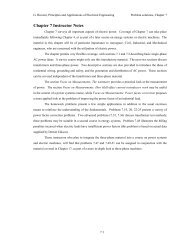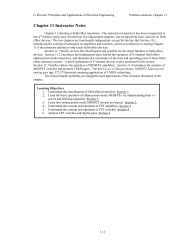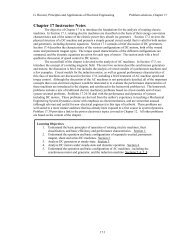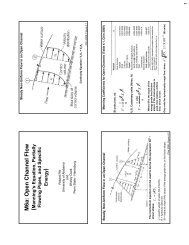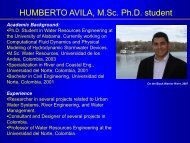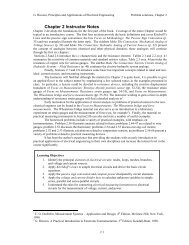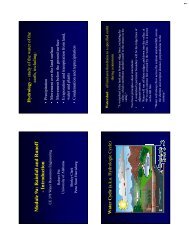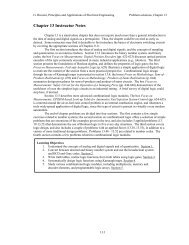Introduction to Electrodynamics - ch09.pdf - Tistory
Introduction to Electrodynamics - ch09.pdf - Tistory
Introduction to Electrodynamics - ch09.pdf - Tistory
Create successful ePaper yourself
Turn your PDF publications into a flip-book with our unique Google optimized e-Paper software.
Chapter 9Electromagnetic WavesProblem 9.1a:: = -2Ab(z - vt)e-b(z-vt)2; ~~1 = -2Ab [e-b(Z-vt)2- 2b(z - vt)2e-b(Z-vt)2] ;8ft = 2Abv(z - vt)e-b(z-vt)2, 82ft = 24bv -ve-b(Z-vt)2 + 2bv [(z - vt)2e-b(Z-vt)2 = V282ft .;m '~ . ] M'M ~h 2.8z = Abcos[b(z - vt)]; 8z2 = -Ab sm[b(z - vt)];8h 82h 2 2 . 282 h8t = -Abvcos[b(z- vt)]; 8t2 = -Ab v sm[b(z:- vt)] = v 8z2";813 -2Ab(z - vt) 82h -2Ab BAb2(z- vt)2- - . -- + .8z - [b(z- vt)2 + 1]2' 8z2 - [b(z- vt)2 + 1]2 [b(z- vt)2 + 1]3'813 = 2Abv(z-vt); 82h = -2Abv2 + BAb2v2(Z-vt)2 =v282h..;8t [b(z- vt)2 + 1]2 8t2 [b(z- vt)2 + 1]2 [b(z- vt)2 + 1]3 8z28i4 = -2Ab2ze-b(bz2+vt). 8214 = -2Ab2 e-b(bZ2+vt) - 2b2z2e-b(bZ2+vt) .8z [ ]I 8Z2 '8i4 - - Ab -b(bz2+vt). 8214 - Ab2 2 -b(bz2+vt) -J. 2 82 i48t - ve , 8t2 - v e -r v 8Z2'8 is 3 82 is 2 . 3 8 is 3 3 2 . . 38z = Abcos(bz) cos(bvt) ; 8z2 = -Ab sm(bz) cos(bvt) ; 8t = -3Ab v t sm(bz) sm(bvt) ;8;~5 = -6Ab3v3t sin(bz) sin(bvt)3 - 9Ab6v6t4 sin(bz) coS(bvt)3 =I V2~~5 .Problem 9.2Usethe trig identityM ~i8z = Akcos(kz)cos(kvt); 8z2 = -Ak2 sin(kz) cos(kvt);~~ = -Akvsin(kz) sin(kvt); ~:; = -Ak2v2 sin(kz) cos(kvt) =v2 ~:{. ./sin a cos 13= ~[sin(a + t3) + sin(a - 13)]<strong>to</strong> writei = I~ {sin[k(z + vt)] + sin[k(z - vt)]},157
158 CHAPTER 9. ELECTROMAGNETIC WAVESwhich is of the form 9.6, with 9 = (Aj2) sin[k(z - vt)] and h = (Aj2) sin[k(z + vt)].Problem 9.3(A3)2 = (A3eiO3) (A3e-iO3) = (A1eiOl + A2eio2) (A1e-iol + A2e-io2)= (Ad2 + (A2)2 + A1A2 (eiOle-io2 + e-iOleio2) = (Ad2 + (A2)2+ A1A22cos(61- 62);A3 = Iv(Ad2 + (A2)2 + 2A1A2 cos(61 - 62).1A3eio3 = A3 (cos 63 + i sin 63) = Al (cos 61 + i sin 61) + A2 (cos 62 + i sin 62)... A3 sin 63 Al sin 61+ A2 sin 62- (AI COS61 + A2 cos (h) + z(AI sm 61 + A2 sm 62). tan 63 = A 6 = ;3COS 3 A1cos61 +A2coS6283 -(-1 AI sin 61 + A2 sintan .Al COS81 + A2 cos82)Problem 9.482j 1 82jThe wave equation (Eq. 9.2) says 8 z2 = v-:1 8 t 2. Look for solutions of the form j(z, t) = Z(z)T(t). Plug.d?Z 1 d2T 1 d2Z 1 d2Tthis in: T dZ2 = V2 Z dt2 . Divide by ZT : Z dZ2 = v2T dt2 . The left side depends only on z, and therighS0 both must be constan t. Call the con stant - k2.t Si~~;nly on t,- = -k 2Z =} Z k k(z ) = Ae1 Z + Be-1 Zdz2 ,{ ~t:; = _(kV)2T =} T(t) = Ceikvt + De-ikvt. }(Note that k must be real, else Z and T blow up; with no loss of generality we can assume k is positive.)j(z, t) = (AeikZ + Be-ikz) (Ceikvt + De-ikvt) = A1ei(kz+kvt) + A2ei(kz-kvt) + A3ei(-kz+kvt) + A4ei(-kz-kvt).The general linear combination of separable solutions is thereforej(z,t) = 100 [AI (k)ei(kz+U.lt) +A2(k)ei(kz-U.lt) +A3(k)ei(-kz+U.lt) +A4(k)ei(-kz-U.lt)] dk,where W ==kv. But we can combine the third term with the first, by allowing k <strong>to</strong> run negative (w = Iklvremains positive); likewise the second and the fourth:j(z,t) = i: [Al(k)ei(kzwtJ +A2(k)ei(kZ-U.ltJ] dk.Because (in the end) we shall only want the the real part of j, it suffices <strong>to</strong> keep only one of these terms (sincek goes negative, both terms include wavestraveling in both directions); the second is traditional (though eitherwould do). Specifically,Re(f)= i: [Re(Ad cos(kz + wt) - Im(Ad sin(kz + wt) + Re(A2) cos(kz - wt) - Im(A2) sin(kz - wt)] dk.The first term, cos(kz + wt) = cos(-kz - wt), combines with the third, cos(kz - wt), since the negative k ispicked up in the other half of the range of integration, and the second, sin(kz+wt) = - sin( -kz -wt), combineswith the fourth for the same reason. So the general solution, for our purposes, can be written in the formj(z, t) =i: A(k)ei(kz-U.ltJdkqed (the tildes remind us that we want the real part).
159Problem 9.5. T 8gI 1 8gI 8hR 1 8hR 8gT 1 agTEquatlOn 9.26 ~ gI(-VIt) + hR(VIt) = gT(-V2t).Now_ = --- 8 8;_ = -- 8 8; - = ---8 8 .Z VI t Z VI t Z V2 t. 1 8gI( -vIt) 1 8hR(VIt) 1 8gT( -V2t) VIEquatIOn 9.27 ~ -- 8 + - 8 = -- 8 ~ gI( -VIt) - hR(VIt) = -gT( -v2t) + K,VI t VI t V2 t V2(where K,is a constant).( VI ) ( 2V2 V2VI + V2)Adding these equations, we get 2gI( -VI t) = 1 + - gT( -V2t)+K" or gT( -V2t) = gI( -VIt)+K,(where K,I== -K, V2 ). Now gI(Z, t), gT(Z, t), and hR(Z, t) are each functions of a single variable u (in theVI + V2first case u = Z - VI t, in the second u = Z - v2t, and in the third u = Z + VIt). ThusgT(U)= (2V2) VI + V2gI(VI UIV2) + K,I.,IMultiplyingthe first equation by VdV2 and subtracting, (1-~) gI(-vIt) - (1 + ~:) hR(VIt) = K, ~(V2- VI) ( V2 ) (hR(VIt) = gI( -VIt) - K, , or hR(u) = gI( -u) + K .VI + V2 VI + V2 VI + V2[Thenotation is tricky, so here's an example: for a sinusoidal wave,gI = AI cos(klz - wt) = AI cos[ki(z - VIt)] ~ gI(U) = AI cos(ki u).gT AT cos(k2z - wt) AT cos[k2(z - V2t)] ~ gT(U) = AT cos(k2u).{ hR = ARCOS(-kIz-wt) = ARCOS[-kdz+VIt)] ~ hR(u)=ARcos(-klu).. . AT 2V2 AR V2 - VI VIHere ",I =0, and the boundary condItions say = , Ā Ā = (same as Eq. 9.32), and 2kI = k2I VI + V2 I VI + V2 V(consistent with Eq. 9.24).]Problem 9.6V2- VI)I(a) T,;n9+ - T,;n9- ~ ma => IT (¥Zlo+ - ¥ZIJ ~ m~lo'(b) AI + AR = AT; T[ik2AT - iki (AI - AR)]= m( -W2 AT), or ki (AI - AR) = (k2 - im;2) AT.-(mw2)- -Multiplyfirst equation by ki and add: 2kIAI = ki + k2 - iT AT, or AT = ki + k2 - imw21T AI.- - - 2kl.- (ki + k2- imw2lT) - - k2 + imw2lT) -AR - AT - AI - AI - AI.ki + k2 - imw2IT ki + k2 - imw2IT(kiIf the second string is massless,so V2= JT IP2 = 00, then kd ki = 0, and we have AT = (1~ i{3) AI,-Ā( l+i{3 h {3 _mw2_m(kIvI)2_mkIT1 - Z )AI I PI PI - Z(2kI) -~- ki N( l+i{3 ) - A i . hR = ---=- {3I, were = k T - k T - - T-, or - m-. ow _ 1. {3- e , WIt( 1 + i{3 )( 1 - i{3 )2 -- - i - (1 + i{3)2 - 1+ 2i{3- {32A - 1 - i{3 1 + i{3 - 1 ~ A-I, and e - (1 - i{3)(l+ i{3)- 1 + (32 ~tan. ~ 1 ~fJ" Thus ARe'" ~ e" Aie;" => I AR ~ Ai. II OR = 01+tan-' (~) .1..( 2 - i 2 -) ( 2 )( 2 - 4 A - 2SImIlarly, 1 - i{3 - Ae ~ A - 1 - i{3 1 + i{3) - 1 + {32~ - J1+732'
liT160 CHAPTER 9. ELECTROMAGNETIC WAVESAei= 2\1 + i{3) = 2(1 + i{3)I (1 - ~(3)(1+ i{3) (1 + (J2) =} tan 4>= {3.I 2 II AT= J1+i32AI; 1= iiI + tan-1 {3.12 "A Ȧ ior.e"" Ie ,So ATeiOT = J1+i32(a) F = T-a ?6.z -'- aProblem 9.7a2f af a2f a2f a2f afz- t.6.z= JL.6.z-t- z- t ta ? ' or T a = 'J JL a +'- 2 a '? -(b) Let ](z, t) = F(z)e-iwt; then Te-iwt~~~ = JL(-r.,})Fe-iwt+ ,(-iw)Fe-iwt =}d2F - d2F -2 - -2 W - - 1, - 1,T z = -w(JLW+ if)F, - d 2 = -k F, where k (JLW+ if). Solution: F(z) ==-T = Ae"z + Be-' z.dzzResolvek in<strong>to</strong> its real and imaginary parts: k =k + iK, =}P = k2 - K,2 + 2ikK,= f(JLW+ if).w, W,( W, ) 2 1 2kK, = - JLW2=}K, = -' k2 - K,2= k2 - - - = -' or k4 - k2 (JLW2/T ) - (w, /2T ) 2 = 0 =}T 2kT ' 2T k2 T'k2 = ~ [(JLw2IT):J:v(JLw2IT)2 + 4(w,/2T)2] = !!Jfl-[1:J: VI + bIJLw)2]. But k is real, so k2 is positive,soiJLj w, I [ ] -1/2we need the plus sign: k = wyIT 1 + VI + bIJLw)2. K,= 2kT = ..j2TJL 1 + VI + blJLw)2 .Plugging this in, F = Aei(k+iK)Z + Be-i(k+iK)Z= Ae-Kzeikz + BeKze-ikz. But the B term gives an exponentiallyincreasing function, which we don't want (1 assume the waves are propagatingin the +z direction),so B = 0, and the solution is I ](z, t) = Ae-Kzei(kz-wt).1 (The actual displacement of the string is the real par<strong>to</strong>f this, of course.)(c) The wave is attenuated by the fac<strong>to</strong>r e-Kz, which becomes lie whenz = ~ = ..j2T JLj 1 + 0-+(,1 JLw)2;Ithis is the characteristic penetration depth.K, ,-( k1-k-iK, ) -1 + k + 'I'"(d) This is the same as before, except that k2 --*k + iK,. From Eq. 9.29, AR = k "AI;( AR 2) =( k1-k-i"' )( k1-k+i"' = (k1-k)2+",2. AR= (k1-k)2+",2AIAI k1+k+i", k1+k-i", ) (k1+k)2+K,2 (k1+k)2+",2(where k1 = WIV1 = wVJLl/T, while k and K,are defined in part b). Meanwhile(k1 - k - (k1 - k - i",)(k1 + k + iK,) (k1)2 - k2 - ",2 - 2i",k1;: -1 -2k1K,k1 + k + i",i"') (k1 + k)2 + K,2 (k1 + k)2 + K,2 ((k1)2 - k2 - ",2= = =} UR = tan .Problem 9.8(a) fv(z,t) = Acos(kz - wt)x; fh(z,t) = Acos(kz - wt +90°) y = -A sin(kz - wi) y. Since i?; + f~ = A2, the vec<strong>to</strong>rsum f = fv + fh lies on a circle of radius A. At time t =0, f = Acos(kz)x - Asin(kz)y. At time t = n)2w, f =A cos(kz-900) x- A sin(kz-900) y = A sin(kz) x+A cos(kz) y.Evidently it circlesI counterclockwiseI. Tomake a wavecirclingthe other way, use lih = -90°.(b);J:at t ='Tr/ 2W"---z /V/;J:\, /" / - /)zy
161(c) Shake it around in a circle, instead of up and down.Problem 9.9(a) kk( w )~w~ ~ ~=-~x; n=z. .r= -~x . xx+yy+zz ) =-~x; kxn=-xxz=y.Iw ~ ~ ~ IE(x,t) = Eocos(~x + wt) z; B(x, t) = ~o cos(~x + wt) y.~ ~ ~ ~:/;xyzy, I" I, 1" I, I" I, I',Iz(a)(b)(b) I k ~ ~ (X +~+ z) ; fi ~ ~.I(moce fi;, p""allel <strong>to</strong> the x z plane, it mu,t have the fo,m ax +~z;sinceft. k = 0,/3= -0:; and since it is a unit vec<strong>to</strong>r, 0: = 1/V2.)x yk'r= % (x+y+z).(xx+yy+zz)= % (x+y+z); kxft= ~ 1 1 1Iv3c v3c v6 1 0 -1z1= j6(-x+2y-z).Problem 9.10E(x, y, z, t)= Eocos[~c(x+y+z) -wt] (x;/);wB(x,y,z,t) = Eo ecos [ V3c(x+y+z)-wt j6 .] ( -X+2Y-Z )P =£ = 1.3 x 10: = 14.3 x 10-6 N/m2 .1 For a perfect reflec<strong>to</strong>r the pressure is twice as great:c 3.0 x 1018.6X 10-6 N/m2 .1 Atmospheric pressure is 1.03 x 105N/m2, so the pressure of light on a reflec<strong>to</strong>r is(8.6x 10-6)/(1.03 x 105)= 18.3X 1O-11 atmospheres.!
-----..162 CHAPTER 9. ELECTROMAGNETIC WA YESProblem 9.11(fg) = 1 (TIf Jo acos(k. r - LVt+ 8a)bcos(k. r - LVt+ 8b) dtab (T ab 12T Jo [cos(2k. r - 2LVt + 8a + 8b) + cos(8a - 8b)] dt = 2T c~s(8a - 8b)T = 2abcos(8a - Ob).Meanwhile, in the complex notation: j = aeikor-"'t),9 = beikor-",t),where a = aeioa, b = beiob. So1- 1 . (k ) - . (k ) 1 - 1 0
0 sinProblem 9.14Equation 9,78 is replaced by Eolx + EORllR = EOTllT,and Eq, 9.80 becomesEotY - EoR(zx fiR) =(3EOT(zx llT), The y component of the first equation is EoR sin()R = EoT sin()T; the x component of thesecond is EoR sin()R = -{3EoT sinDT, Comparing these two, we conclude that sin()R = sin()T = 0, and henceeR= OT= 0, qedProblem 9.15Aeiax + Beibx = Ceicx for all x, so (using x = 0), A + B = C,Differentiate: iaAeiax + ibBeibx = icCeicx, so (using x = 0), aA + bB = ca.Differentiate again: -a2 Aeiax - b2Beibx = -c2Ceicx, so (using x = 0), a2A + b2B = c2C.a2A + b2B = c(cC) = c(aA + bE); (A + B)(a2 A + b2B) = (A + B)c(aA + bE) = cC(aA + bE);a2A2+ b2AB + a2AB + b2B2= (aA + bB)2 = a2A2 + 2abAB + b2B2, or (a2 + b2- 2ab)AB = 0, or(a - b)2AB = 0, But A and B are nonzero, so a =b. Therefore (A + B)eiax = Ceicx,a(A + B) = cO, or aC = cO,so (sinceC f:.0) a = c. Conclusion:a = b= c. qedProblem 9.16Ē Ē i(kt.r-""t) AI - Ote y,{HI = VIIEolei(kl"r-""t)(-COSOI X+sin()1 z);Ē R - ĒORe i(kR'r-""t)Ay,}kR:/:163{HR = :1 EoRei(kRor-""t)(cos 01X + sin 01z);Ē Ē i(kTor-""t) AT - OTe y,}z{ HT = :2 EoTei(kTor-""t) (- COSO2X + sin ()1z); }( ' ) E .L E .L ( U' ) E ll E ll1 £1 1 = £2 2' 111 1 = 2'Boundary co~ditions:{ (ii) B.L = B.L (iv) .!..BII = .!..BII,1 2 , 1'1 1 1'2 2O2 V2Law of refract~on: --=--sm 1 VIexponential fac<strong>to</strong>rs in applying the boundary conditions.]0= -, [Note: kI 'r - VJt= kR 'r - VJt = kT . r - VJt,at z = 0, so we can drop allBoundary condition (i): 0 = 0 (trivial), Boundary condition (iii): I Eot + EoR= EoT.1B d d " U1( ) Ē' 1 '() Ē ()1 Ē. () E-Ē( VI sin ()2 ) Ēoun ary con ItlOn 11: - Ot sm 1 + - ORsm 1 = - OTsm 2 => Ot + OR = . () OT'VI VI V2 V2 sm 1But the term in parentheses is 1, by the law of refraction, so this is the same as (ii).1 1 - 1 -1-Boundary condition (iv): - -EOt(-COS()I) + -EoR COS()1= -EoT(-COS()2) =>J.ll [ VI VI ] J.l2V2- -( J.lIVI J.l2V2cos 1 COS 1 J.l2V2COS()2 ) - COS()2 ; {3==-, J.lIVI Then 1- Eot - EoR - = a{3EoT. - IEOt - EoR = () EoT' Let a ==- ()Solving for EoR and EoT: 2Eot = (1 + a{3)EoT => EoT = (1 +2a{3) Eol;- - -( 2 1 + a{3 ) - - ( 1 - a{3 ) -Eon= EoT - Eot = 1 + a{3 - 1 + a{3 Eot => EoR = 1 + a{3 Eol'Since a and {3are positive, it follows that 2/(1 + a{3) is positive, and hence the transmitted wave is in phasewith the incident wave, and the (real) amplitudes are related by I EoT = (~) EOt,1 The reflected wave isBJ
164 CHAPTER 9. ELECTROMAGNETIC WAVESin phase if 0:(3< 1 and 1800 out of phase if 0:(3< 1; the (real) amplitudes are related by I EOR =: I~ I Eo/.These are the Fresnel equations for polarization perpendicular <strong>to</strong> the plane of incide~ce.VI - sin2 ()/(32 J (32- sin2eTo construct the graphs, note that 0:(3=: (3 cos e =: cos e' where ()is the angle of incidence,. \12.25 - sin2eso, for (3=: 1.5, 0:(3=: cos e'1-!i-/\-7-0-5--1-3-2-1O' 10 20 30 40 50 60 70 /\0!i0 81Is there a Brewster'sangle? Well, EOR=: 0 would mean that 0:(3=: 1, and hence that( V2 2 . 2) ( P2V2 2 2)Vl- (v2/vt)2sin2() 1 P2V20: =: =: - =: -, or 1- - sm () =: - COS(), socos () (3 PI VI VI PI VI1 =: (~:) 2 [sin2 () + (p2f PI)2 COS2e]. Since PI ~ P2, this means 1 ~ (V2/Vt)2, which is only true for opticallyindistinguishable media, in which case there is of course no reflection-but that would be true at any angle,not just at a special "Brewster's angle". [If P2 were substantially different from PI, and the relative velocitieswere just right, it would be possible <strong>to</strong> get a Brewster's angle for this case, at( VI 2 =: 1- cos2e) +( P2 2 cos2e => cos2e =: (VdV2)2 -1 =: (P2f2fPIfI) -1 =: (f2/ft) - (PdP2) .V2 PI ) (p2/pt)2-1 (p2fpd2-1 (p2/PI)-(pdp2)But the media would be very peculiar.]By the same <strong>to</strong>ken, ORis either always 0, or always 7[',for a given interface-itchange (), the way it does for polarization in the plane of incidence. In particular,.)2.25 - sin2e .(3f . 2 () 2 e . 2 e20: =: cos () > 1 1 2.25 - sm > cos , or 2.25 > sm + cos e =: 1. ,(In general, for (3 > 1, 0:(3> 1, and hence OR =: 7['. For (3 < 1, 0:(3< 1, and iSH=: O.does not switch over as youif (3 =: 3/2, then 0:(3> 1, forAt normal inc'idence, 0: =: 1, so Fresnel's equations reduce <strong>to</strong> EoT =: (1 ~ (3) Eo/; EOR =: Iconsistent with Eq. 9.82. ,~ ~ ~ I EonReflection and Transmission coefficients: IR =: (~~:)2 =: (~ ~ :~) 2.1 Referring<strong>to</strong> Eq. 9.116,
165( ) 2 I (T = E2V2a EOr = a{3 ~) 2EIVI Eol 1 + a{3 .R + T = (1 - a{3)2+ 4a{3= 1 - 2a{3+ a2{32 + 40:{3 = (1 + a{3)2= 1 ./(1 + a{3)2 (1 + a{3)2 (1 + 0:{3)2 .Problem 9.17Equation 9.106 ~ {3= 2.42; Eq. 9.110 ~VI - (sinB/2.42)2a= .cosB(a) B = 0 ~ 0: = 1. Eq. 9.109 ~- 1.42 I I1 + 2.42 = - 3.42 = -0.415;(~:~) = a: {3 = 3.~2 = 10.585.1(b) Equation 9.112 ~ BB = tan-l (2.42) = !67.5°.1(c) EoR =Eor ~0:-{3=2;0:={3+2=4.42;(4.42)2COS2B = 1 - sin2 B/(2.42)2;(4.42)2(1- sin2 B) = (4.42)2- (4.42)2sin2B= 1 - 0.171 sin2 B; 19.5 - 1 = (19.5 - 0.17) sin2 B;18.5 = 19.3 sin2 B; sin2 B = 18.5/19.3 = 0.959;sine = 0.979; Ie = 78.3°.1Problem 9.18(a) Equation 9.120 ~ r = E/a.( EOR Eol )0:-{30:+{3Now f = fofr (Eq. 4.34), lOr~ n2 (Eq. 9.70), and for glass the index ofrefraction is typically around 1.5, so 10~ (1.5)2 x 8.85 X 10-12 = 2 X 1O-11C2/N m2, while a = 1/ P ~ 10-12 n m(Table 7.1). Then r = (2 x 1O-11)/1O-12 =~ (But the resistivity of glass varies enormously from onetype <strong>to</strong> another, so this answer could be off by a fac<strong>to</strong>r of 100 in either direction.)(b) For silver, p = 1.59 X 10-8 (Table 7.1), and f ~ EO,so c..Jf= 21TX 1010 x 8.85 X 10-12 = 0.56.Since a = 1/ P = 6.25 X 107 » c..JE, the skin depth (Eq. 9.128) is1.00.80.60.40.20--0.2--0.4-0.6-------------------91d = ~ ~ Vc..J~fL= V 21TX 1010 x 6.25 ~ 107 x 41TX 10-7 = 6.4 X 10-7 m = 6.4 x 10-4 mm.I'd plate silver <strong>to</strong> a depth of about 1 0.001 mm; I there's no point in making it any thicker, since the fields don'tpenetrate much beyond this anyway.(c) For copper, Table 7.1 givesa = 1/(1.68 x 10-8) = 6 X107, c..JEO= (21TX 106) x (8.85 X 10-12) = 6 X 10-5.Since a »c..JE, Eq. 9.126 ~ k ~ Vc..J~fL, so (Eq. 9.129)2A = 21f - = 21f = 4 X 10-4 m = 0.4 mm.c..JafLo 21f x 106 X 6 X 107 X 41T X 10-7 I I~ Vi,From Eq. 9.129, the propagation speed is v = ~ = ~ A = AV = (4 X 10-4) X 106 = 1400m/s.! In vacuum,,\ = ; = 3 ;0~08 = 1300 m; Iv = c =13 X 108m/s.1 (But really, in a good conduc<strong>to</strong>r the skin depth is so small,compared <strong>to</strong> the wavelength, that the notions of "wavelength" and "propagation speed" lose their meaning.)
166 CHAPTER 9. ELECTROMAGNETIC WAVESProblem 9.19(a) Use the binomial expansion for the square root in Eq. 9.126:~ ~ w f€i,ff1 2So (Eq. 9.128) d:;:: - ~ - -. Qed~ a P1/2 :;::W f€i,~!!-.:;:: ~ ~.V2: 1 + ~ [ ( !!-. ) 2 - 1 2 EW ] V2:y2EW 2V~E:;:: ErEO :;:: 80.1EO (Table 4.2),For pure water,p :;::po(l + Xm) :;::po(1 - 9.0 X 10-6) ~ PO (Table 6.1),{ a:;:: 1/(2.5 x 105) (Table 7.1).So d :;:: (2)(2.5 X 105) (80.1~~.~51~-~0-12):;:: 11.19 X 104 m.1(b) In this case (aIEw)2 dominates, so (Eq. 9.126) k ~~, and hence (Eqs. 9.128 and 9.129)21f 21f ,\,\ :;:: - ~ - :;:: 21fd, or d :;:: -. Qedk ~ 21fMeanwhile ~ ~ WVf€i, 2:Vfa -;;:; :;:: Vwpa:;:: 2 (1O15)(41f x2 10-7)(107) :;:: 8 X 107; d :;:: .!. ~ :;:: ---2 8 X 1071.3 X 10-8 :;:: 113nm.1 So the fields do not penetrate far in<strong>to</strong> a metal-which is what accounts for their opacity.(c) Since k ~~, as we found in (b), Eq. 9.134 says q;:;::tan-l(l) :;::45°. QedP ff "I. Bo VH. BoMeanwhile, Eq. 9.137 says (1O7)(41fX 10-7)Ē ~ EP-:;:: -. For a tYPIcal metal, then,Ē :;:: 15:;::0 EW W 0 10!1O-7 s/m.! (In vacuum, the ratio is lie:;:: 1/(3 x 108) :;::3 X 10-9 slm, so the magnetic field is comparativelyabout 100 times larger in a metal.)Problem 9.20:;::(a) u:;:: ~ (EE2 + tB2) :;:: ~e-2I
w168 CHAPTER 9. ELECTROMAGNETIC WAVESW2 = w5 =F Wol', W = woV1 =F I'/wo ~ Wo (1 =F 1'/2wo) = Wo =1= 1'/2. SO W2 = ""0+ 1'/2, ""1 = ""0 - 1'/2, and thewidth ofthe anomalous regionisI .6"", = ""2-""1= 1'.1 'Nq2",,2 I' . Nq2From Eq, 9,171, Q = - mCOc (2""0 - W- ?)2 + I' 2"" 2' so at the maximum ("" = ""0), Qrnax = -, mcoCT'o)? N q2w2 T'( ",,2 At WI and ""2, W- = ""0 =F ""0T', so Q = - 2 2 OJ2 = Qrnax ? 2. Butmcoc I' ""0+ r"" ""-+ ""0)",,2 - ""6=1=""01' - ~ (1 =1=1'/""0)!:>< 1 =1=--1- ~ )!:>
8Ez 8Bz.. i(8Ez 8Bz)-k 8y + w 8x ' or (ll) Ey = (w/c)2 - k2 k 8y - w 8x .M I . I ( " ) b I 2 ( . ) b k d dd ' W 8Ez .wk .E k2 B k 8Bz .w2 .wku tIp y II Y w c, VI Y , an a . 2- B E8 - Z2 y + Z x - _ 8 - Z2 x - Z2 y :}c y c x c c. 2 W28Bz w 8Ezi(( )( "' 8Bz w 8Ez)z k - 7!i Bx = k 8x - C2 8y , or 11l Bx = (w/c)2 - k2 k 8x - C2 8y ).2 .wk w 8Ez 8Bz . 2 .w2 iwkMultiply (iii) by w/c , (v) by k, and subtract: z2Ex - 2- - k-c c 8 x 8 y+ zk By = z2Byc+ ~Exc:}. 2 W2W 8Ez 8Bz. i( )(8Bz wz k - 7!i By = c2 8x + k 8y , or (IV) By = (W/C)2 - k2 k 8y + c28Ez) 8x .This completes the confirmation of Eq. 9.180.(b) V. E = 8Ex + 8Ey+ 8Ez=(8Eo> + 8Eoy + ikEo)ei(kz-",t) = 0 => 8Ex + 8Ey + ikEz = o.8x 8y 8z 8x 8y z 8x 8y. ii82Bz) .USIngEq. 9.180, (w/c)2 - k2 k 8X2 + w8x8y + (W/C)2- k2 k 82y - w8x8y + zkEz = 0,82 Ez 82 Ez[( I ) 2 2 ](82Ez 82Bz)or 8X2 + 82y + W c - k Ez = O.Likewise, V . B = 0 => 8:Xx + 8~y + ikBz = 0 =>i(k 82Bz - W 82Ez)+ i k 82Bz + W 8Ez + ikBz = 0 =>( )(w/c)2 - k2 8X2 c2 8x8y (w/c)2 - k2 8y2 C28x8y82Bz 82Bz2 2[ ]8x2 + 82y + (w/c) - k Bz = O.This confirms Eqs. 9.181. [You can also do it by putting Eq. 9.180 in<strong>to</strong> Eq. 9.179 (i) and (iv).]Problem 9.27Here Ez = 0 (TE) and w/c = k (n = m = 0), so Eq. 9.179(ii) => Ey = -cBx,(82Ez169Eq. 9.179(iii) =>Ex = cBy,Eq. 9.179(v) => 8~z = i (kBy - ~Ex) = i (k_3y- ~By) = 0, Eq. 9.179(vi) => 8:Xz = i (kBx + ~Ey)=i (kBx - ~Bx) = O. So 8:Xz = 8~z = 0, and since Bz is a function only of x and y, this says Bz is in facta constant (as Eq. 9.186 also suggests). Now Faraday's law (in integral form) says f E . dl = -! ~~ . da,and Eq. 9.176 => ~~ = -iwB, so f E. dl = iwf B. da. Applied <strong>to</strong> a cross-sectionof the waveguidethis givesf E . dl = iwei(kz-",t)! Bz da = iwBzei(kz-",t) (ab) (since Bz is constant, it comes outside the integral). Butif the boundary is just inside the metal, where E = 0, it follows that I Bz = 0.1So this wouldbe a TEM mode,which we already know cannot exist for this guide.Problem 9.28Here a = 2.28 em and b = 1.01 em, so VlO = -.!...WlO = 2c = 0.66 X 1010 Hz; V20 = 2 2c = 1.32 X 1010Hz;211" a ac c 10 C 10 C ~V30 = 32a = 1.97 x 1010 Hz; VOl = 2b = 1.49 x 10 Hz; V02= 22{;= 2.97x 10 Hz;Vll = "2V;;2+ b2=1.62 X 1010 Hz. Evidently just four modes occur: 110, 20, 01, and 11.1To get only one mode you must drive the waveguide at a frequency between VlO and V20:10.66x 1010 < V < 1.32 X 1010 Hz.! A = ~, so AlO = 2a; A20 = a. 12.28em < A < 4.56 em.!V
170 CHAPTER 9. ELECTROMAGNETIC WAVESProblem 9.29FromProb. 9.11,(S) = - 2 1 (E x B*). Here (Eq. 9.176)E = Eoei(kz-wt), B* = B~e-i(kz-wt), and, for theJ-LoTEmn mode (Eqs. 9.180 and 9.186)B; =B; =B; =-ik.( m1l"x ) ( n1l"Y (c.vjC)2- k2 ~ Bosm ~ CDSb ) ;-ik(c.vjc)2_k2 b Bocos ~ sm b ;( -m1l" )( -n1l" ) ( m1l"x ) . ( n1l"Y )Bo CDS(m:x) CDS(n;y) ;ic.vEx =( -n1l" ) ( m1l"x ) . ( n1l"Y (c.vjC)2- k2 b BoCDS~ sm b ) ;-zc.v( -m1l" .) ( m1l"X ) ( n1l"Y Ey = (c.vjc)2- k2)Ez = O.~ Bo sm ~ CDS b ;So(S) =!(S) .da =- 1 i1l"c.vBg2 { ( j ) 2 k 2 - sm - J-Lo c.vc - a a CDS - a ) CDS - bi1l"c.vBg( n 2) ( m1l"X ) . ( n1l"Y ) ( n1l"Y )A+ (c.vjc)2- k2 b CDS ~ sm b CDSb Y( m ) . ( m1l"X ) ( m1l"x2(n1l"Y)n)2 2(m1l"X). 2(n1l"Y) (m)2. 2 (m1l"X)2(n1l"Yc.vk1l"2 B5A+ - CDS - sm - + - SIll - CDS - z.}[(c.vjC)2- k2]2 [( b a b a a b1 c.vk1l"2 B2 m 2-[( ) ( n ) 2 0 2 ab - + - b .I [In the last step I used8J-Lo[(c.vjc)2- k2] a]Ax)]Joasin2(m1l"xja) dx = Joacos2(m1l"xja) dx = aj2; J: sin2(n1l"yjb) dy = J: cos2(n1l"yjb) dy = bj2.]Similarly,(u) ==( -- 1-- )1- foE.E*+-B.B*4 J-LofO c.v211"2Bgn[( ) 2 2 ( m1l"x ) . 2 ( n1l"Y ) ( m ) 2. 2 ( m1l"x 2- - CDS - sm - + - sm - CDS) ( n1l"Y -4 [(c.vjc)2- p]2 b a b a a b )]+ ~ {B2 COS2 (m1l"x ) COS2 ( n1l"Y )4J-Lo 0 a bn)2 2(m1l"X). 2(n1l"Y). (m)2 . 2(m1l"X)2(n1l"Yk211"2B5+ - CDS - SIll - T - sm - CDS - .[(c.vjc)2- k2]2[(b a b a a b)] }! lab fo c.v211"2 Bg n 2{[( ) ( m ) 2 Bg 1 k211"2 Bg' n 2][( ) ( m ) 2] (u) da ="4 "4 [(c.vjc)2- k2]2 b + ~ + 4J-Lo + 4J-Lo [(c.vjc)2- k2]2 b + ~ } .
171These results can be simplified, using Eq, 9.190 <strong>to</strong> write [(U.l/C)2- k2] = (U.lmn/c)2,follo = l/c2 <strong>to</strong> eliminate€o,and Eq. 9.188 <strong>to</strong> write [(m/a)2 + (n/b)2] = (U.lmn/7rc)2:/U.l2ab 2(8) . da = U.lkab~2B5i8/l-0U.lmn / (u)da = 8lloU.lmn2 Bo'Evidentlyenergy per unit time - J(8) .da kc2 cenergy per unit length - J(u)da = -::; = ~";U.l2-U.l~n = Vg(Eq. 9.192). qedProblem 9.30Following Sect. 9.5.2, the problem is <strong>to</strong> solve Eq. 9.181 with Ez =F0, Bz = 0, subject<strong>to</strong> the boundaryconditions 9.175, Let Ez(x,y) = X(x)Y(y); as before, we obtain X(x) = Asin(kxx) + Bcos(kxx). But theboundary condition requires Ez = 0 (and hence X = 0) when x = 0 and x = a, so B = 0 and kx = m7r/a.But this time m = 1,2,3,... , but not zero, since m = 0 would kill X entirely, The same goes for Y(y), ThusEz =Eosin (m:x) sin (n;y) with n, m = 1,2,3,... .The rest is the same as for TE waves: I U.lmn= c7rv(m/a)2 + (n/b)21 is the cu<strong>to</strong>ff frequency, the wavevelocity is v = c/Vl - (U.lmn/U.l)2, and the group velocity is Vg = cVl- (U.lmn/U.l)2.The lowest TM mode is11, with cu<strong>to</strong>ff frequency U.l1l= c7rv(l/a)2 + (l/b)2. So the ratio of the lowest TM frequency <strong>to</strong> the lowestTE frequency is C7rV(I{:;~~ (l/b)2 = I VI + (a/b)2.1Problem 9.31(a) V.E = ~~(sEs) = 0./; V.B = ~~(B",) = 0./; V xE = oEs (b-~ oEsz = - Eoksin(kz - wt)(b:bs as s o OZ s o saB EoU.lsin(kz - U.lt);. /( . k / ) V BoB", A 1 a A( BEok sin(kz - U.lt)A ?)at c s oz s as c s- - = - - '/J" sInce = U.l C ; x = - - s + - - s q, z = - s =1 aE EoU.lsin(kz - U.lt)A . . II2~ = ~ s ./. Boundary condItions: E = Ez= 0 ./;Bl. = B8= 0./.C ut c s(b) To determine A, use Gauss's law for a cylinder of radius s and length dz:E.daf = Eo cos(kz - U.lt) (27rs)dz = -Qenc 1 = -Adz 1 => II A= 27rfoEocos(kz-U.lt).S fO fOITo determine I, use Ampere's law for a circle of radius s (note that the displacement current through this. .E " h A d ' . )f B dl Eo cos(kz - U.lt) 27'0Eo(2 ) 1 I(k )c S lloCoop ISzero, SInce ISIn t e S IrectlOn: . = - 7rS = Ilo enc => = - cos z - wt .The charge and current on the outer conduc<strong>to</strong>r are precisely the I opposite I of these, since E = B = 0 insidethe metal, and hence the <strong>to</strong>tal enclosed charge and current must be zero.Problem 9.321j(z,O) =i: A(k)eikz dk => i(z, 0). = i: A(k).e-ikz dk. Let I ==-k; then i(z, °t =-000000A(-WeilZ(-dl) = A(-Weilz dl = A(-k).eikZ dk (renaming the dummy variable 1-+ k).100 -00 -00j(z,O) = Re [i(z,O)] = ~ [i(z,O) + !(z,o).] = roo _21 [A(k)+ A(-k).] eikz dk. Therefore2 1-001
A(k)172 CHAPTER 9. ELECTROMAGNETIC WAVESIjoo1 r - -'k::)IA(k)+A(-krf(z,O)e-,'zdz.'" L ] =-2 7r -00Meanwhile, fez, t) = i: A(k)( -iw)ei(kz-"'t) dk => f(z,O) = i: [-iwA(k)]eikz dk.(Note that w = Iklv, here, so it does not come outside the integral.)j = j = 1j(z,O)* = -oc [iwA(k)*]e-ikz dk = -00 [ilklvA(k)*]e-ikz dk = = [illlvA(-l)*]eilz(-dl)= i: [ilklvA(-k)*]eikz dk = i: [iwA( -k)*]eikz dk._=j(z,O) = Re [fez,0)] = ~ [f(z,O)+ fez,0)*] = i: ~[-iwA(k) + iwA( -k)*]eikz dk.-~w [A(k) - A(-k)*] = 2~ i: j(z,O)e-ikZ dz, or ~ [A(k) - A(-k)*] = -f; i: [~j(Z,O)] e-ikz dz.Adding these two results,we get IProblem 9.33rsm- Ij=(a) (i) Gauss's law: V .E = --J:ō a;:: = O. .I(ii)Faraday'saBatlaw:[= 2; -00 f(z,O) + ;:;f(z,O) e-.kz dz.1 Qedu
173(iv) Ampere/Maxwell:VxB18EC2 8t= 2EocasO 1 1 1 1~ wr kcasu(- - k r 2 casu - -r sinu - kcasu + - k r 2 casu + -rsinu = O. ..(= 1 A8 8Br-r-(rEo) - - cp[ 8r 80 ]1 8==(b) Poynting8 ===Eo sin 0(1 1-:;.{ 8r [ w -k cas u + kr2 cas u + -:;.sin u - 80 [ wr2 sin u + kr cas u cpEo sin 0(2 . 2 1. 1. k 2. 2)~k smu - -casu - - smu - -smu + - casu+ -smu + -casu cpwr kr3 r2 r2 r r2 kr3k Eo sin 01( )~ 1 Eo sin 0 1( )~- k sin u + - casu cp= - k sin u + - cas u cp.w r r c r r1 Eo sin 0(. w)~ 1 w Eo sin 0(. 1)~2"cr. wsinu + -kr casu cp= 2" c -k r k sm u + -rcasu cp1 Eo sin 0- k sm u + - casu cp= V x B. ..(c r rVec<strong>to</strong>r:1 Eo sin 0( . 1 )~(1 .)]) [ 2Eo cas 0 ( . 1 )A) ]-(E x B) = casu - - k smu 2 smu + - kcasu ()/Lo /Lor r wr rEo sin 01 1.(~+ wr -kcasu+ kr2 casu+ -:;.smu (-r)E2 sin 0 2 cas 0 . 1 1.~0 2 - sm u cas u{+ -[k(cas2 u - sin 2 u) -k 2 ? sm u cas u ()/Lowr r r r-].8)2Eo cas 0(1- o( k 2 1 2 1. 1. 1 . 1 2sm - cas u + ~ cas u + -:;. smu casu + -:;. sm u cas u - W sm u cas u - kr2 sin u rEJ sin0 2cas0 1 . 1 2 .{ [( )A/Lowr2 -;:-- 1 - k2r2 smu casu + kr (cas u - sm2u) ] ()+ sin 0 [(- ~ + k21r3) sin u cas u + k cas2 u + k~2 (sin2 u - cas2 u)] r}.Averaging aver a full cycle, using (sin u cas u) = 0, (sin2 u) = (cas2 u) = ~, we get the intensity:1= (8) = E5 sinO (~sinO ) r =E5 sin2 0 r./Lowr2 2 I 2/Locr2It points in the r direction, and falls off as 1/r2, as we would expect far a spherical wave.!E2 sin20 E2 " 47r E2(c) P = I. da = - 2 0 ~r2 sin 0 dOdc/>= -0 27r sin3 OdO 2= -~.1!/LoC r /LoC 0 3 /LoC)] }) ~ }~
174 CHAPTER 9. ELECTROMAGNETIC WAVESProblem 9.34xCDzy{OEI - En = {3(Er- El), where {3==VdV2.VI VI V2 V2Z - d.Z < 0:EI(Z, t) = Elei(kIZ-UJt)X, BI(Z, t) =VI.lE1ei(kIZ-UJt)yEn(z, t) = Enei(-kIZ-UJt) X, Bn(z, t) = - ;1 Enei(-kIZ-UJt) y.Er(z, t) = Erei(k2Z-UJt) x,EI(Z, t) = Elei(-k2z-wt) X,Ereik2d + Ele-ik2d == ETeik3d;-. { ]...Ereik2d- ]...Ele-ik2d = ]...ETeik3d=>Ereik2d- Ele-ik2d = aETeik3d, where a ==v2/v3.V2 V2 V3~B ( z t) = .lE ei(k2z-wt)r, V2 r YBl(Z, t) = - vl2Elei(-k2z-wtj y.We have here four equations; the problem is <strong>to</strong> eliminate En, Er, and El, <strong>to</strong> obtain a single equation forET in terms of EI.Add the first two <strong>to</strong> eliminate En : 2E1 = (1 + {3)Er + (1 - {3)El;Add the last two <strong>to</strong> eliminate El : 2Ereik2d = (1 + a)ETeik3djSubtract the last two <strong>to</strong> eliminate Er : 2E1e-ik2d = (1 - a)ET eik3d.Plug the last two of these in<strong>to</strong> the first:2EI= (1 + {3)~e-ik2d(1 + a)ETeik3d + (1 - {3)~eik2d(1 - a)ETeik3d2 24EI = [(1+ a)(1 + {3)e-ik2d+ (1- a)(1 - {3)eik2d] ETeik3d= [(1 + a{3) (e-ik2d + eik2d) + (a + {3)(e-ik2d - eik2d)] ETeik3d= 2 [(1+ a{3)cos(k2d)- i(a + {3)sin(k2d)] ETeik3d.
175J.LOfaNow the transmission coefficient is T = vafaE<strong>to</strong> = Va( )Problem 9.35l1El12 Ia IETI2 aII~TI2 = VI I~TI2 = a IETI2VlflElo VI J.Lofl IEl12 Va IEl12 /3IEI12' soI .. 'T-I = - /3;:--- = - /3_2[(1 + a/3) cos(k2d) - z(a + /3) sm(k2d)] etkad= 4~/3 [(1 + a/3)2cos2(k2d)+ (a + /3)2sin2(k2d)]. But cos2(k2d)= 1 - sin2(k2d).= 4~/3 [(1 + a{3)2+ (a2 + 2a{3+ (32- 1- 2a{3- a2{32)sin2(k2d)]- 14a [(1 + a{3)2 - (1 - a2)(1 - (32)sin2(k2d)] .{3=c c c na n2But ni = -, n2 = -, na = -, so a = -, {3= -.VI V2 Va na nl1[(n2n2 )(n2 n2 )- (nl + na)2 + 1 - 2 2 a - 2 sin2(k2d) .4nlnan2T = 1 => sinkd = 0 => kd = 0,11',211' The minimum (nonzero) thickness is d = 1I'/k. But k = w/v =(Eq, 9.69), where (presumably) J.L~ J.Lo.So n = Vf/fO = Fr, and hence27rv/v = 211'vn/c, and n = VfJ.L/fOJ.LO1I'C c 3 X 108 -a I Id = 211'vFr = - 2vFr = 2(10 x 109) ~ 2.5 = 9.49.x 10 m, or 9.5 mm.Problem 9.36From Eq, 9.199,T-l = 14(4/3)(1) { [(4/3) + 1]2+ [(16/9) - (9/4)][1 (9/4)- (9/4)] Sin2(3wd/2C) }3 49 (-17/36)(-5/4). 249 85 . 2= 16 [ "9 + (9/4) sm (3wd/2c)]= 48 + (48)(36)sm (3wd/2c).T = 48 .49 + (85/36) sin2(3wd/2c). . 2 48 I ISillcesm (3wd/2c) ranges from 0 <strong>to</strong> 1, Tmin = 49 + (85/36) = 0.935; Tmax= 48 49 = rnnon-l ~ Not muchvariation, and the transmission is good (over 90%) for all frequencies. Since Eq. 9.199 is unchanged when youswitch 1 and 3, the transmission is the same either direction, and the I fish sees you just as well as you see it. IProblem 9.37(a) Equation 9.91 => ET(r,t) = EoTei(kT,r-I4It); kT' r = kT(sinOTx + COSOTZ)' (xx + yy + zi) =kr(x sin OT + Z cos OT) = xkT sin OT + izkTV sin2 OT- 1 = kx + iK,z,where.nl . ,..lnl .k == kTsmOT= - -smOI = -smOl,( Wn2 )c n2 cK, == kTvsin2 OT - 1 = W;2 v(nl/n2)2 sin2 01 -1 = ~/n~ sin201- n~. SoET(r, t) = EOTe-ltzei(kx-l4It). Qed]12
176 CHAPTER 9. ELECTROMAGNETIC WAVES.-(b) R = ~::112 2= I: ~~I. Here /3is real (Eq. 9.106) and a is purely imaginary (Eq. 9.108); write a = ia,( ia-/3 )( -ia-(3 ) a2+(32w + -w + a +with a real: R = -:--- /3 '/3 = 2 (32 =[I]1-a(311(c) From Prob, 9,16, EOR= 1 + a(3 EO1,so R =11+ a(31= 1 1 + ia(3 / = (1 + ia/3)(l - ia(3) = L!:J1-a(3(d) From the solution <strong>to</strong> Prob. 9.16, the transmitted waveis21-ia(32 (l-ia(3)(l+ia(3) f1lAE ( r , t) = EOT ei(kT'r-uJt)Y , :B(r,t) = ~EoTei(kT.r-"'t)(-cos(hx+sin(hz).V2Using the results in (a): kT.r=kx+iK,z-wt, sinOT= ck, cosOT=i CK,:wn2wn2E(r, t) = EoTe-l
177- f2J.L2UJEoe-l
178 CHAPTER 9. ELECTROMAGNETIC WAVEScomponents, then by Fourier analysis this equation could not be satisfied (for all x, y, and z) unless the otherthree constants were also zero, and we'd be left with no field at all.) It follows that -(Bkx + Dky + Fkz) =a(in order that V . E = 0), and we are left withE = B cos(kxx) sin(kyY) sin(kzz) x + D sin(kxx) cos(kyY) sin(kzz) y + F sin(kxx) sin(kyY) cos(kzz) z,with kx = (m7r/a), ky = (n7r/b), kz = (l7r/d) (l, m, n all integers), and Bkx + Dky + Fkz = O.The corresponding magnetic field is given by B = -(i/(;.)V x E:Or:Bx -By =Bz -- ~ (88~z - 8ffzY) = - ~ [Fkysin(kxx)cos(kyY)cos(kzz) - Dkz sin(kxx)cos(kyY)cos(kzz)],-~ (8ffzx - 88~z) = -~ [Bkz cos(kxx) sin(kyY)cos(kzz) - Fkx cos(kxx) sin(kyY) cos(kzz)],-~ (88~y - 8~x ) = -~ [Dkxcos(kxx) cos(kyY)sin(kzz) - Bky cos(kxx) cos(kyY)sin(kzz)].B = -i(Fky - Dkz) sin(kxx)cos(kyY)cos(kzz) x - i(Bkz - Fkx) cos(kxx) sin(kyY) cos(kzz) Y(;.) (;.)- ::"'(Dkx - Bky) cos(kxx) cos(kyY) sin(kzz) z.(;.)These au<strong>to</strong>matically satisfy the boundary condition B1. = 0 (Bx = 0 at x = 0 and x = a, By = 0 at Y = 0 andY = b, and Bz = 0 at z = 0 and z = d).As a check, let's see if V . B = 0 :iiV . B = --(Fky (;.) - Dkz)kx cos(kxx) cos(kyY) cos(kzz) - -(Bkz (;.) - Fkx)ky cos(kxx) cos(kyY) cos(kzz)z- -(Dkx (;.) - Bky)kz cos(kxx) cos(kyY) cos(kzz),z= --(Fkxky (;.) - Dkxkz + Bkzky- Fkxky + l)kxkz - Bkykz) cos(kxx) cos(kyY)cos(kzz) = O..(The boxed equations satisfy all of Maxwell's equations, and they meet the boundary conditions. For TEmodes, we pick Ez = 0, so F = 0 (and hence Bkx + Dky = 0, leaving only the overall amplitude undetermined,for given l, m, and n); for TM modes we want Bz = 0 (so Dkx - Bky = 0, again leaving only one amplitudeundetermined, since Bkx + Dky + Fkz = 0). In either case (TElmn or TM1mn), the frequency is given by(;.)2= c2(k; + k~ + k;) = c2 [(m7r/a)2+ (n7r/b)2+ (l7r/d)2J,or 1(;.)= c7rv(m/a)2 + (n/b)2 + (l/d)2.1


